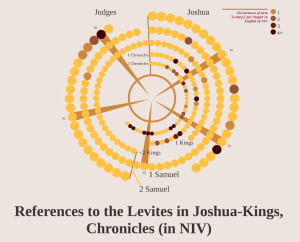“Hey Mo, don’t you worry ’bout goin’ down south,
I’ll be sayin’ every word that comes outta your mouth,
Just be doin’ your best, and pray that it’s blessed,
I’ll take care o’ the rest.”
– Keith Green, “He’ll Take Care of the Rest”
Noticing that Psalm 2 had in common with Exodus 15 (the Song of Moses) and a range of other texts an unusual form of the 3rd masc. plural (usually) pronominal suffix, ‘מוֹ’ (-mo), I became interested in just where those endings turned up, why they might exist, and whether any significant implications stem from these features.
So let me offer an Excel chart that shows their distribution and specific references:
Distribution Chart for -mo 3mp pronominal suffixes

The distribution of these endings is interesting. It shows clusters of its use on verbs (esp. Exod 15), nouns (e.g. Ps 2:3) and prepositions (normally ‘עַל’ or ‘לְ’, once ‘אֶל’, Ps 2:5). For instance, Exodus 15 features seven such suffixes, exclusively on verbs, whereas all the prophetic uses are on prepositions, and then only in Isaiah and once in Habakkuk. A few more observations:
- The suffix is normally plural but occasionally singular, as in the Genesis references.
- The suffix can occur in parallel construction with the regular 3mp ending, as in Ps 49:11.
- The form is almost always found in poetry, though the poetry/prose boundary is difficult to identify in prophetic discourse (affecting the Isaiah references). Exod 23:31, however, is a prose use.
A point of interest for me is whether this is an archaic form or instead an ‘archaizing’ form, a stylistic touch implying traditional authority or fidelity, e.g. continued use of archaic English forms by churchgoers reciting the Lord’s Prayer. The Psalm 49 instance might suggest a stylistic use. I suspect that some clusters are genuinely archaic, including Exodus 15. Isaianic usage probably reflects use of this suffix largely restricted to prepositions in the middle of the Old Testament period. Some of the Psalms uses, especially later ones, occur in proximity to references to Israel’s distant past, e.g. 78:24, 66; 83:11; 99:7.
It is challenging to find where secondary sources discuss this phenomenon, but see Gesenius/Kautsch/Cowley #32m (pp. 107-8 in my edition), #58g (156-7) re verb suffixes, #91b, h, l (255-258) re noun suffixes, and #103f, o (301-2, 305) re suffixes on prepositions. #91l debates the implications of such forms for dating, in the authors’ case, denying that they can be relied upon to be genuine signs of archaism, while those of the Albright school (e.g. Cross, Freedman) might take them as betraying the archaic nature of a poem like Exodus 15. (See Cross, Canaanite Myth and Hebrew Epic, 86, for a sample reference to Exodus 15 and the beginning and ending of Deuteronomy 33 in these terms. You’ll notice that all feature this suffix abundantly.)
I would assume that ancient Hebrew language like any other has a history and a course of development, and that it must be possible to arrive at some conclusions on the basis of phenomena such as the one mentioned here. I believe that the authors behind Miller-Naudé, Cynthia L., and Ziony Zevit (eds.). Diachrony in Biblical Hebrew (Winona Lake: Eisenbrauns, 2012) would advocate this position, though I haven’t yet read the volume. With the same proviso, I understand that the opposing position is put in Young, I., R. Rezetko, and M. Ehrensvärd. Linguistic Dating of Biblical Texts (London: Equinox, 2008). Let’s all check them out!





